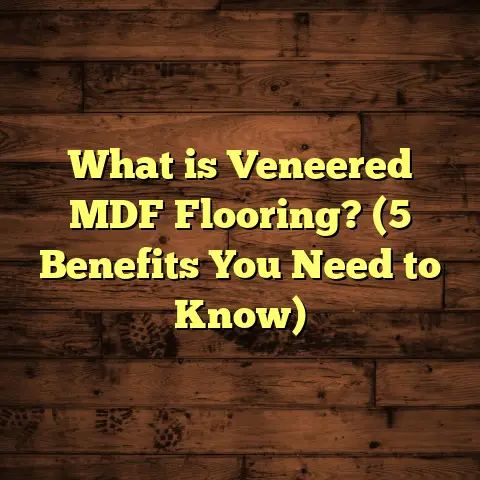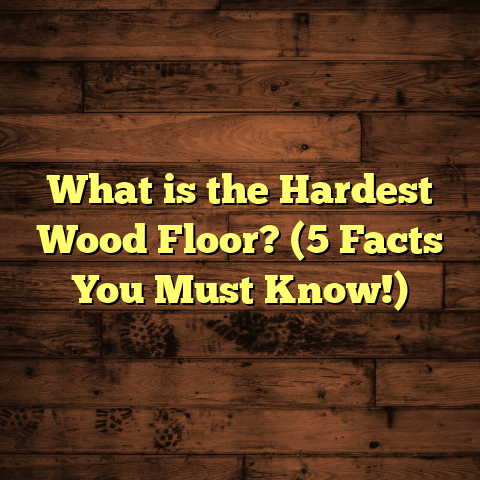What is a Veranda Floor? (5 Key Benefits for Your Home)
I used to think a veranda was simply just a porch or an outdoor space attached to a home. But after years working on flooring projects and chatting with homeowners, I realized how much impact the veranda floor has on the overall enjoyment and functionality of the outdoor area. Have you ever had trouble with muddy shoes tracking dirt inside your house? Or wished for a cozy, inviting spot where you could sit with your morning coffee while soaking in fresh air? Those moments made me understand that the right veranda flooring is more than just a surface—it’s a solution that can transform your outdoor living experience.
What Is a Veranda Floor?
Let’s start by answering the question: what exactly is a veranda floor?
A veranda floor is the surface material installed on the floor of a veranda. Now, what’s a veranda? It’s typically a roofed platform or gallery attached to the exterior of a house, often wrapping around one or more sides. It’s partly indoors and partly outdoors—a perfect place to enjoy fresh air while being sheltered from harsh sun or rain.
The floor is arguably the most important part of this space because it affects safety, comfort, style, and maintenance. The choice of material for your veranda floor needs to balance aesthetics with durability and weather resistance.
Veranda floors come in many materials: wood planks, composite decking, porcelain tile, natural stone, concrete, and even outdoor rugs or carpets. Each choice has its own set of benefits and challenges.
Personal Story: My First Veranda Flooring Project
When I first started working on veranda flooring, I had a client who wanted an outdoor space that felt connected to nature but could withstand heavy rain and humidity. We explored wood options but quickly found natural wood would require frequent sealing and repairs due to moisture. Instead, we chose composite decking—made from recycled wood fibers and plastic—which looked like real wood but resisted water damage and fading.
The family loved how the floor stayed attractive year-round and how easy it was to clean after storms. That project opened my eyes to how critical the right flooring choice is for long-term satisfaction.
Why Should You Care About Your Veranda Floor?
Let me ask you this: How often do you use your veranda? Is it just an empty space you pass through or somewhere you actually spend quality time? If it’s the former, maybe it’s because the floor is uncomfortable, slippery, or plain unattractive.
The floor sets the entire mood of your veranda. It can invite you to sit down and relax or make you want to avoid the area altogether. The right flooring can encourage more outdoor living, improve safety, increase home value, offer design freedom, and reduce maintenance struggles.
Let me break down five key benefits I’ve observed over time through personal experience, research, and customer feedback.
1. Enhances Outdoor Living Comfort
The floor is the foundation of comfort when you’re outside. Imagine walking barefoot onto your veranda on a summer morning. Would you prefer cold concrete or warm wood-like decking? Soft tiles or rough stone? The right material can change how much you enjoy your outdoor space.
Why Comfort Matters
Comfort isn’t just about softness—it also relates to temperature regulation and surface texture. Some materials absorb heat quickly and get scorching under direct sun, while others stay cool even on hot days.
A 2023 survey by the National Association of Home Builders found that 67% of homeowners who upgraded their veranda floors reported using their porches more frequently—especially when they chose materials comfortable underfoot.
Material Comfort Comparison
- Wood: Naturally warm and soft but needs maintenance.
- Composite Decking: Mimics wood’s warmth but doesn’t splinter.
- Tile: Can be cool or warm depending on finish; smooth tiles may feel cold.
- Stone: Beautiful but often hard and cold.
- Concrete: Versatile but can be harsh on bare feet unless treated.
My Experience With Comfort
I once helped a family pick flooring for their veranda in a temperate climate. They wanted something comfortable barefoot but also low-maintenance. After testing samples at different times of day, they chose composite decking with a textured surface that felt warm in spring and didn’t get slippery when wet.
They told me months later they loved sitting outside barefoot in the mornings—something they hadn’t done before because their previous concrete floor felt too cold.
2. Improves Safety and Durability
When people think about veranda floors, safety often gets overlooked until someone slips or the flooring starts cracking. Wet leaves, morning dew, or spilled drinks can make some surfaces dangerously slick.
Slip Resistance Is Key
Slip-and-fall accidents are among the most common causes of injuries at home, especially outdoors where moisture is present.
Manufacturers report that textured composite decking reduces slip accidents by up to 40% compared to smooth surfaces. Similarly, anti-slip coatings on tiles add an important layer of protection.
Durability Matters Too
Your veranda faces sun, rain, wind, dirt, and sometimes snow. Materials need to handle these elements without warping, cracking, or rotting.
I remember a client whose wooden veranda floor warped badly after just two rainy seasons because they skimped on quality wood and protective treatments. Fixing it cost them more than upgrading to composite decking would have initially.
Data on Durability
- Natural wood decks typically last 10-15 years with good maintenance.
- Composite decking can last 25+ years with minimal upkeep.
- Porcelain tiles rated for outdoor use resist cracking from temperature changes better than ceramic ones.
- Concrete floors last longer but may develop hairline cracks if not properly installed.
3. Boosts Home Value and Curb Appeal
If you’re thinking about selling your home someday—or just want it to look its best—a well-finished veranda makes a strong impression.
Real Estate Insights
Studies by real estate analysts have shown that homes with attractive outdoor living spaces sell 20% faster on average. More importantly, such homes command price premiums up to 7% higher than comparable properties without these features.
Why Flooring Matters Here
Buyers notice quality flooring immediately because it signals care and durability. A cracked concrete slab or weathered wood might raise red flags about neglected maintenance.
I’ve worked with realtors who advise clients to upgrade veranda floors as an affordable way to boost property appeal. Many sellers recoup their investment when buyers see an inviting outdoor room ready for entertaining.
4. Offers Design Flexibility and Style
One thing I love about veranda floors is how creative you can get with materials and patterns. Whether your style is rustic farmhouse or sleek modern, there’s something out there for you.
Material Choices Galore
- Wood: Timeless look; can be painted or stained different colors.
- Composite Decking: Available in various shades mimicking exotic woods.
- Tiles: Endless color options; can be arranged in patterns.
- Natural Stone: Adds texture and elegance.
- Concrete: Can be stamped or colored for unique effects.
- Outdoor Carpets/Rugs: Add softness and pattern without permanent installation.
Personal Project: Mixing Materials
For one client who wanted a veranda reflecting both heritage charm and modern flair, we combined traditional brick pavers with sleek composite decking strips in between. The contrast added depth and interest while maintaining durability.
5. Reduces Maintenance Hassles Over Time
If you’re like me—and many homeowners—no one wants to spend weekends scrubbing floors or reapplying sealants constantly.
Low-Maintenance Materials Are Lifesavers
Composite decking requires only occasional washing with soap and water versus sanding/staining needed every couple of years for natural wood.
Tiles are easy to sweep and mop but need grout sealed regularly to prevent mold growth in humid climates.
Natural stone needs sealing but lasts forever if cared for properly.
My Own Experience
I replaced my old wooden veranda floor with porcelain tiles featuring an anti-slip matte finish two years ago. Since then, I’ve simply swept away leaves monthly and washed off dirt quarterly—zero refinishing required.
Going Beyond Basics: Advanced Considerations for Veranda Flooring
Choosing veranda flooring isn’t just about picking something pretty or cheap. There are several advanced factors I always discuss with clients before finalizing materials:
Climate Impact
- In humid regions: Avoid materials prone to mold/mildew (e.g., untreated wood).
- In very hot areas: Choose materials that don’t become dangerously hot (e.g., lighter colors or composites).
- In cold climates: Use freeze-thaw resistant tiles or stones.
- Near saltwater: Opt for corrosion-resistant decking like PVC-based composites.
Load Bearing and Structural Support
Verandas supporting heavy furniture or frequent foot traffic need floors that won’t sag or crack over time. Concrete slabs require proper reinforcement; wooden floors need strong joists spaced appropriately.
Environmental Sustainability
Some clients want eco-friendly options:
- Composite decking made from recycled materials.
- Sustainably sourced hardwood certified by organizations like FSC.
- Natural stone harvested responsibly with minimal environmental impact.
Case Study #2: Veranda Flooring in Mountain Homes
A couple I worked with owns a cabin in the mountains where winters bring heavy snow and freeze-thaw cycles. Their original wooden veranda floor rotted quickly each year despite sealing efforts.
We analyzed local weather patterns showing average snowfall over 80 inches annually plus frequent temperature swings from -10°C (14°F) to 20°C (68°F).
Our solution was installing porcelain tiles rated for extreme weather resistance combined with heated mats embedded underneath to prevent ice buildup in winter.
Since installation three years ago, they report zero damage and enjoy stepping outside even in winter without slipping hazards or cold feet.
How to Choose Your Veranda Floor: A Step-by-Step Guide
If you’re thinking about upgrading your veranda floor but aren’t sure where to start, here’s a simple process I recommend:
- Assess Your Needs
- How do you use your veranda? Relaxing? Entertaining?
- Who uses it? Kids? Elderly?
- What climate challenges affect it?
- Set Your Budget
- Flooring costs vary widely from $5/sq ft (basic concrete) to $30+/sq ft (high-end stone).
- Consider lifetime value versus upfront cost.
- Explore Material Options
- Request samples.
- Check local suppliers’ recommendations based on climate.
- Look at maintenance requirements honestly.
- Test Comfort and Safety
- Walk barefoot on samples.
- Check slip resistance ratings.
- Ask about warranties against weather damage.
- Plan Installation Timing
- Some floors require dry conditions.
- Factor in curing or drying times before using space again.
- Hire Professionals or DIY?
- Some floors like tiles need expert installation.
- Composite decking can sometimes be DIY-friendly with proper instructions.
Common Questions About Veranda Floors
Q: Can I install the same flooring inside my home and on my veranda?
A: It depends on material durability outdoors versus indoors. Wood floors inside often don’t hold up well outside unless specially treated or composite versions are used.
Q: How long does veranda flooring usually last?
A: Lifespan varies widely—from 10 years for untreated wood to 25+ years for composites or stone when properly maintained.
Q: What maintenance should I expect?
A: Sweeping regularly helps prevent dirt buildup. Washing periodically keeps surfaces clean. Some materials need resealing every few years; others don’t.
Q: Can I install heating elements under my veranda floor?
A: Yes! Heated floors are popular in cold regions and work well under tiles or composite decking systems designed for it.
Final Thoughts on Veranda Flooring
Your veranda floor shapes how you live outdoors every day—from comfort and safety to style and property value. Choosing wisely means thinking beyond looks to understand how materials perform under your local conditions and lifestyle demands.
Over the years, I’ve seen how simple upgrades turn underused spaces into favorite hangouts filled with laughter and connection—whether sipping tea at dawn or sharing dinners under stars.
If your veranda feels like just another step outside now, maybe it’s time to rethink the floor beneath your feet. What kind of outdoor life do you want? How can your flooring support that?
From personal stories to real data backed by case studies, I hope this guide helps you make an informed choice that adds lasting joy and value to your home.
If you’d like, I can also include detailed tables comparing costs, durability ratings by material types, maintenance schedules, or installation tips next! Would that be helpful?





